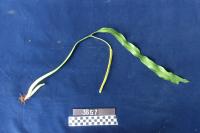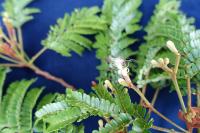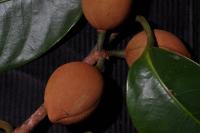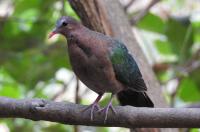This page has returned 100 entries
nähäwanatschill
n. Macaranga dioca
Example: Inner bark: bathe in cold infusion, wounds. Mix heated over fire and taken out during sunset. Healer clenches the package in his fist, then gently punches the patients left, then right knee, then his forehead and finally squeezes over his head, migraine a
bookmarknahca
n. a burden of pandanus leaf
bookmarknahcai milmat
nahcaijap
n. kind of tree
bookmarknahed u paralecei

nahed u paralelcei

nahein

n. shrub to 1 m tall, frits green. Red clay soil (collection: Michael J. Balick #4880)
Example: Stems are used to produce cyclone houses--secure wild cane (Miscanthus) on the roof of the house. Fold cane in half over the stem of this plant and then lay it on the roof. Makes layers that resist the wind. The stem of this plant can be sharpened to make a fishing spear, or used as the shaft and a few wires are attached to the end.
bookmarknaheñ

naheñ

naheñ

naheñ

n. tree, 4 m tall (collection: Gregory M. Plunkett #4066)
Example: 1. Young saplings are used to prepare a fishing spear. First a straight sapling is chosen and sized. Then it is heated over a fire to render it pliable. After the length is straightened, it is decorticated. Once cooled, a portion of wire can be affixed to an end to aid in spearing fish.
bookmarknaherumaig
n. mimosa (plant)
bookmarknahi ateuc
n. a plant with white flowers; a lily
bookmarknähiväing
n. Macaranga dioca
Example: Inner bark: bathe in cold infusion, wounds. Mix heated over fire and taken out during sunset. Healer clenches the package in his fist, then gently punches the patients left, then right knee, then his forehead and finally squeezes over his head, migraine a
bookmarknahleuco yag
n. kind of taro
bookmarknahmas
n. kind of plant, grass, or fern
bookmarknaho
n. a plant, the fruit of which is prepared like arrowroot, and used as a food for sick people
bookmarknahoacen

n. vine to 3-4 m, aerial tubers brown (collection: Michael J. Balick #4872)
Example: Normally these fruits are considered poisonous. But, people have learned to peel off the skin of the fruits, put the peeled fruits in a conical basked and place a bamboo tube that is dripping water over it to wash the basket of fruits for 3-5 days. This is said to leach out the poison and the end result is similar in consistency to cheese. Wrap this up with leaves and put it in an earth oven to cook. This plant is eaten as a "starvation food" only, consumed in times of drought and famine.
bookmarknahoai
n. a plant from which twine is made
bookmarknahod

nahoij
n. kind of tree
bookmarknahoijcei
n. the name of a species of creeper
bookmarknahoj

n. tree, 7 m tall (collection: Gregory M. Plunkett #3646)
Example: The ripe fruits of this species smell very nice and people eat the inside part, which tastes similar to a banana. When fruit is ripe the outside is yellow and the inside is purple. The wood can be used for poles to make house rafters. When kids go fishing for shrimps they use the fruit to catch the shrimp by throwing the shrimp into the water which attracts the shrimp.
bookmarknahoj

nahojcei

n. low-growing vine, growing next to airstrip just beyond coastal vegetation. Flowers purple. (collection: Gregory M. Plunkett #3544)
Example: To trap fish, the vine of this plant is rolled in large quantity and put on the reef in a circle at high tide in order to corral and trap the fish. At low tide the fish are then speared and harvested. Placement of the circle depends on the rocks and the reef. Children fold the large leaves and bite parts of the leaf to make designs as a craft object. This is a "message plant." If a person wants to build a house or garden in a specfic place, put a piece of the vine on a stick near the area to tell others that they should not build a garden or house hear this area--this is a Tabu message. There are a few other unspecified leaves added to the stick, not only this one.
bookmarknahojcei

nahojcei

n. scrambling vine, growing in coastal strand vegetation. Flowers purple. (collection: Gregory M. Plunkett #3436)
bookmarknahraren nepig
n. dawn of day
bookmarknahrarin nepig
n. early morning; around 3 o’clock
bookmarknahren
n. half-tide, ebbing
bookmarknahrin
n. half-tide when ebbing
bookmarknahrin hat
n. kind of taro
bookmarknahrin nij
n. kind of taro
bookmarknahtaicai
n. plant
bookmarknahtancai
n. shrub; small plant
bookmarknahtancai upunupun
n. thorn
bookmarknahtau
n. kind of sugarcane
bookmarknai
n. a plant with red leaves
bookmarknaijema
n. cotton
bookmarknaijema
n. flax
bookmarknaiji elcau
n. kind of sugarcane
bookmarknaipom̃yiv

n. terrestrial plant, 60 cm tall (collection: Gregory M. Plunkett #3498)
Example: Children take a shoot of this plant and make a whistle from it. However, when children do this, they are told not to, as it will attract the rains, or a snake, that will hear the noise and come to the person. This is a folk belief. The base of the shoot of this plant is chewed and applied to fresh cuts as a styptic. Pull out top growth of plant that has not flowered and blow on it like a whistle. Ancestors used this as a whistle to attract snakes for edible – not today. Name means “balls or heaps of snakes” refer to their attraction.
bookmarknaipomyiv ~ naipomñiv

naipumnyu
n. kind of plant, grass, or fern
bookmarknairek

nairo

n. sapling, 3 m tall (collection: Gregory M. Plunkett #4106)
Example: 1. Sapling wood is used to make fishing spears. A straight sapling is first heated in the fire to render it pliable. The sapling is further straightened and then decorticated. Once cooled, wire can be added a prong to the end of the spear.
bookmarknairum̃an

najañ

najeng

n. tree, 8-10 m tall (collection: Gregory M. Plunkett #4017)
Example: 1. Aerial roots have a natural curve that allows them to be used as a clothing hanger. The outer bark is peeled and dried all day in the sun, before the roots are used. 2. Leaves are used to help remove fish bones lodged in one’s throat. When bones are stuck in one’s throat, then you apply young leaves to the outside of the throat. Apply once and leave until the bones are removed.
bookmarknajgou

n. Orange-spotted emperor, yellowtail emperor
Example: Photo by FAO / Fishbase, License: CC BY-NC 3.0 via Fishes of Australia
bookmarknakautefa
n. kind of tree
bookmarknake

nakhe

n. fern. Growing in a village back path. (collection: Ashley A McGuigan #29)
Example: 1. To cure when the anus falls out - Pound together 1 braches worth of inpalcapnesgin leaves and of both inloptiri (2-4 leaves, any age), also take the inner bark of nekeaitimi and nakhe. Put this into your hand, or another leaf and give it to the person to use it. This should be applied to the anus whenever the anus comes out. USed to use a clam shell to extract the bark but not anymore.
bookmarknakli pece
n. isle, island
bookmarknakoaha
n. kind of taro
bookmarknakoai
n. species of palm tree
bookmarknakwai
n. kind of plant, grass, or fern
bookmarknakwei

n. large palm, 20 m tall (collection: Gregory M. Plunkett #4080)
Example: 1. Children eat the nut of the ripe fruits. 2. The leaf bases can be used, when tied together, two at a time, to create a bowl from which to drink. 3. In the past, the trunks were used to fashion a hunting spear used in tribal warfare. Further context withheld.
bookmarknakweiwei

n. treelet to 1 m, sterile. In transition zone from pine forest to scrub forest. (collection: Michael J. Balick #4981)
Example: The wood is used to make a fishing spear. Cut the straight stems, heat it in fire, straighten it as much as needed, cool the stem, peel the bark off of the stem and let it cure for 1 month. In the past, the end of the spear was carved into a sharp point and used for fishing. Now steel rods are placed on the tip to catch the fish. This is used in shallow water (fresh water or sea water) as the wood is heavy and can sink. People making these spears go to older forests that are higher up to collect the wood.
bookmarknala

n. shrub to 2 m, coastal vegetation (collection: Michael J. Balick #4961)
Example: The stem of this plant is used for firewood. If a person has been drinking kava and the next morning feels hung over, they can take a handful of the leaves of this plant, crush them in cool water, and wash their face with this. This treatment will help the kava feeling to disappear.
bookmarknala

n. tree to 7 m, dbh 20 cm (collection: Michael J. Balick #4860)
Example: This is a common tree. If a person travels from one district to another on Aneityum, and you see the tree planted in that other district, a person knows they are free to come into this area. When the leaves are yellow, as in a young tree, the local name is nala’gay. If a person carries a branch of this tree into a village it is a symbol that the person is coming with peaceful intentions.
bookmarknala

nala

nala

n. shrub, 1. 5 m tall (collection: Gregory M. Plunkett #3217)
Example: 1a. When traveling past a community you can place these leaves in a basket or walk with it in your hand. In this way people in the community know that you are traveling in peace and will cause no harm to people in that village. 1b. Message plant – if you go to visit someone and they are not there, you leave a branch of this on the door or somewhere they can see it and they know that some relatives have come and tried to visit them.
bookmarknalad iran
n. seed of a fig
bookmarknalak ahod
n. kind of plantain
bookmarknalak cai
n. kind of plantain
bookmarknalak mariaga
n. kind of plantain
bookmarknalak mideuc
n. kind of plantain
bookmarknalak u nije

nalauba

[nalauba] n. Emerald Dove
Example: Photo by Dr. Raju Kasambe/Wikimedia Commons, License: CC BY-SA 4.0 via Wikimedia Commons
bookmark





